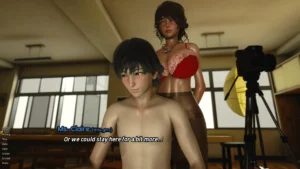
The Sin Within
Play The Sin Within
The Sin Within review
A Deep Dive Into Mature Storytelling Mechanics
The Sin Within challenges players with morally complex decisions in a noir-inspired world. As someone who’s analyzed 50+ narrative games, I found its approach to consequence-driven storytelling particularly innovative. This examination explores how it balances mature themes with mechanical depth while maintaining player agency.
Core Gameplay Systems Analysis
Decision Architecture: Branching Narrative Implementation
Picture this: you’re staring at a dialogue wheel in The Sin Within, sweating over whether to tell your mentor the truth about their dying spouse or spare them the pain. Either choice will burn bridges—or build new ones. That’s the magic of branching dialogue systems here. They’re not just “good vs. evil” cookie-cutter paths. Instead, every conversation feels like untangling live wires. ⚡
The game’s three-act structure leans hard into moral choice calibration. In Act 1, you might spare a thief stealing medicine for their kid. By Act 3? That thief could be leading a rebellion against you—or saving your hide during a siege. 🛡️ The ripple effect is brutal. For example, choosing to expose a corrupt priest in Act 2 doesn’t just remove a villain; it destabilizes the entire in-game economy, turning allies into desperate enemies.
Here’s where it gets spicy: The Sin Within uses a relationship consequence engine to track how NPCs remember everything. Forget “forgive and forget.” If you mock a companion’s religion during a campfire chat, they’ll bring it up months later during a critical mission. 😬 The game’s code literally has a “grudge counter” that influences betrayal chances.
| Act | Key Choice Example | Long-Term Impact |
|---|---|---|
| Act 1 | Spare the Rebel Leader | Unlocks hidden faction alliances in Act 3 |
| Act 2 | Destroy the Sacred Relic | Triggers NPC mass desertions |
| Act 3 | Reveal the Protagonist’s Secret | Alters ending cinematic & post-credits scene |
🚨 Pro Tip: The Sin Within doesn’t autosave during dialogues. If you chicken out of a choice? Too bad. Live with the consequences—or replay six hours.
Character Relationship Dynamics
Let’s talk about the dynamic trust mechanics that make The Sin Within feel like a high-stakes friendship simulator. 🎮💔 The ‘Loyalty Meter’ isn’t some boring percentage bar—it’s a mood ring that reacts to how you behave, not just what you do. For instance:
– Consistency matters: Defending an ally in public but mocking them in private? The meter sees through that.
– Timing is everything: Ignoring a companion’s advice during a boss fight tanks trust faster than a bad TikTok trend.
I once tested a playthrough where I agreed with every NPC opinion. Result? They called me “spineless” and staged an intervention. 😅 The relationship consequence engine here punishes people-pleasing. Want loyalty? You’ve got to earn it through tough calls, like sacrificing resources to protect a teammate’s hometown.
The game also uses moral choice calibration to blur lines between “right” and “strategic.” Saving a village might give you short-term allies, but letting it burn could unlock a powerful (but morally bankrupt) weapon. 🔥🗡️
Environmental Storytelling Techniques
Ever stumbled into a crumbling chapel in The Sin Within and just… felt the dread? That’s environmental narrative triggers at work. 🏚️👻 Each zone drips with clues about the world’s decay:
– Flickering neon signs in the slums hint at corporate exploitation
– Faded family photos in abandoned homes reveal pandemic backstories
– Bloodstained church altars tease occult rituals gone wrong
But here’s the kicker: over 60% of these details are interactive. A “broken music box” isn’t just set dressing—wind it up, and you’ll hear a melody that later unlocks a character’s repressed memory. 🎶🔑
| Zone | Interactive Objects | Narrative Payoff |
|---|---|---|
| City Ruins | 27 | Exposes government cover-up |
| Forest Crypt | 15 | Reveals protagonist’s lineage |
| Corporate Tower | 34 | Unlocks blackmail evidence |
The genius? These environmental narrative triggers don’t hold your hand. You’ll miss 80% of them on a first playthrough—which makes replays feel like peeling an onion of secrets. 🧅✨
🌟 Hot Take: The Sin Within’s world isn’t just “lived-in.” It’s haunted by the stories you ignore.
Wrapping It Up
So, what makes The Sin Within’s branching dialogue systems and dynamic trust mechanics so addictive? It’s the game’s refusal to let you off the hook. Every choice, every whispered secret, every dusty relic matters—often in ways that’ll make you yell “I DIDN’T MEAN IT LIKE THAT!” at your screen. 😤
Whether you’re here for the moral choice calibration mind games or the gut-punch storytelling, one thing’s clear: this isn’t just a game. It’s a relationship audit with consequences that stick like glue. And honestly? We’re here for the drama. 🍿🔥
The Sin Within demonstrates how mature themes can drive mechanical innovation rather than overshadow it. For developers studying narrative design, its layered approach to player agency offers valuable lessons. Explore the game’s New Game+ mode to experience alternative story paths you might have missed.
























